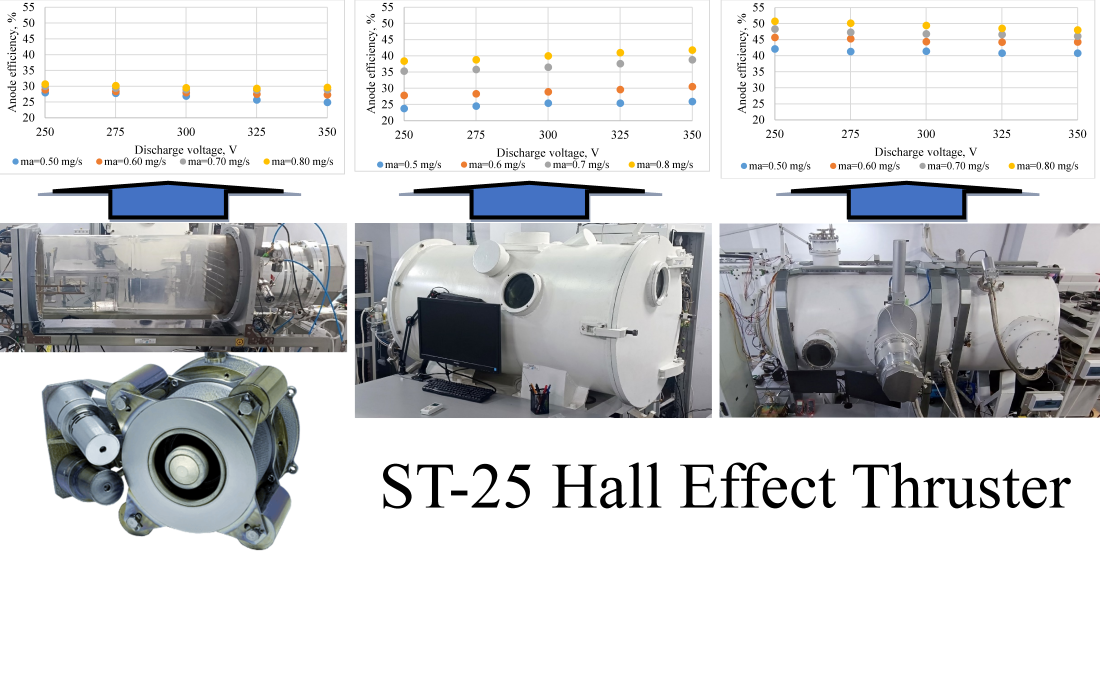Determining the effect of laboratory testing conditions on working parameters of the ST-25 hall thruster
DOI:
https://doi.org/10.15587/1729-4061.2024.301162Keywords:
Hall thruster, residual pressure, engine thrust, specific impulse, engine efficiencyAbstract
The object of this study is the ST-25 Hall thruster with limited discharge power, no more than 200 W, designed by Flight Control LLC (Ukraine). The problem that was solved in the current paper was to determine the effect of residual gas pressure in vacuum chambers on the operating parameters of the Hall thruster. To solve this task, the operating parameters of the ST-25 thruster were determined, which was tested in three vacuum chambers with different sizes of residual pressure. As a result of the laboratory study into the operating parameters of the ST-25 thruster, the volt-ampere characteristics of the engine discharge at fixed values of the working gas (xenon) flow rate were obtained. The dependences of the engine thrust on the mass flow rate of the working gas at fixed values of the discharge voltage were derived. Based on the experimental data, the dependences of the specific impulse of the engine anode unit on the discharge voltage, as well as the dependence of efficiency of the engine anode unit on the discharge voltage were calculated. The studies showed that when the residual pressure in the vacuum chamber is reduced by 2–3 times, the operating parameters of the engine increase by 15–20 %. Such a reduction in residual pressure increases thrust by 25–40 %. Special feature of the results is the determination of threshold values of residual gas pressure in vacuum chambers during experimental studies, in which the operating parameters of the Hall thruster are similar to its operating parameters under space conditions. This work’s findings could be used in practice when conducting experimental studies of electric rocket engines, when it is necessary to estimate the operating parameters of Hall thrusters that will be obtained under actual space conditions
References
- Snyder, J. S., Lenguito, G., Frieman, J. D., Haag, T. W., Mackey, J. A. (2020). Effects of Background Pressure on SPT-140 Hall Thruster Performance. Journal of Propulsion and Power, 36 (5), 668–676. https://doi.org/10.2514/1.b37702
- Piragino, A., Faraji, F., Reza, M., Ferrato, E., Piraino, A., Andreussi, T. (2021). Background Pressure Effects on the Performance of a 20 kW Magnetically Shielded Hall Thruster Operating in Various Configurations. Aerospace, 8 (3), 69. https://doi.org/10.3390/aerospace8030069
- Kerber, T. V., Baird, M. J., McGee-Sinclair, R. F., Lemmer, K. M. (2019). Background Pressure Effects on Plume Properties of a Low-Cost Hall Effect Thruster. The 36th International Electric Propulsion Conference. Available at: https://electricrocket.org/2019/513.pdf
- Frieman, J. D., Liu, T. M., Walker, M. L. R. (2017). Background Flow Model of Hall Thruster Neutral Ingestion. Journal of Propulsion and Power, 33 (5), 1087–1101. https://doi.org/10.2514/1.b36269
- Nakles, M. R., Hargus Jr., W. A. (2009). Hall Effect Thruster Ground Testing Challenges. Proceedings of the 25th Aerospace Testing Seminar. Available at: https://apps.dtic.mil/sti/tr/pdf/ADA506238.pdf
- Nakles, M., Hargus, W. (2008). Background Pressure Effects on Internal and Near-Field Ion Velocity Distribution of the BHT-600 Hall Thruster. 44th AIAA/ASME/SAE/ASEE Joint Propulsion Conference & Exhibit. https://doi.org/10.2514/6.2008-5101
- Cheng, S. Y. (2007). Modeling of Hall Thruster Lifetime and Erosion Mechanisms. The 30th International Electric Propulsion Conference. Available at: http://electricrocket.org/IEPC/IEPC-2007-250.pdf
- Mazouffre, S., Echegut, P., Dudeck, M. (2006). A calibrated infrared imaging study on the steady state thermal behaviour of Hall effect thrusters. Plasma Sources Science and Technology, 16 (1), 13–22. https://doi.org/10.1088/0963-0252/16/1/003
- Voronovsky, D. K., Kulagin, S. N., Maslov, V. V., Petrenko, O. N., Tolok, S. V. (2021). Hall-effect thruster ST-25 with permanent magnet. Journal of Rocket-Space Technology, 28 (4), 37–45. https://doi.org/10.15421/452005
- Petrenko, O., Tolok, S., Maslov, V., Kulagin, S., Serbin, V., Shcherbak, D. (2019). Electric propulsion system SPS-25 with Hall Thruster. 70th International Astronautical Congress 2019. Available at: https://iafastro.directory/iac/paper/id/50659/abstract-pdf/IAC-19,C4,4,4,x50659.brief.pdf

Downloads
Published
How to Cite
Issue
Section
License
Copyright (c) 2024 Olexandr Petrenko, Viktor Pererva, Viktor Maslov

This work is licensed under a Creative Commons Attribution 4.0 International License.
The consolidation and conditions for the transfer of copyright (identification of authorship) is carried out in the License Agreement. In particular, the authors reserve the right to the authorship of their manuscript and transfer the first publication of this work to the journal under the terms of the Creative Commons CC BY license. At the same time, they have the right to conclude on their own additional agreements concerning the non-exclusive distribution of the work in the form in which it was published by this journal, but provided that the link to the first publication of the article in this journal is preserved.
A license agreement is a document in which the author warrants that he/she owns all copyright for the work (manuscript, article, etc.).
The authors, signing the License Agreement with TECHNOLOGY CENTER PC, have all rights to the further use of their work, provided that they link to our edition in which the work was published.
According to the terms of the License Agreement, the Publisher TECHNOLOGY CENTER PC does not take away your copyrights and receives permission from the authors to use and dissemination of the publication through the world's scientific resources (own electronic resources, scientometric databases, repositories, libraries, etc.).
In the absence of a signed License Agreement or in the absence of this agreement of identifiers allowing to identify the identity of the author, the editors have no right to work with the manuscript.
It is important to remember that there is another type of agreement between authors and publishers – when copyright is transferred from the authors to the publisher. In this case, the authors lose ownership of their work and may not use it in any way.









